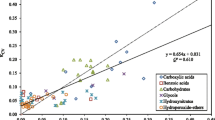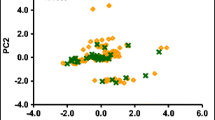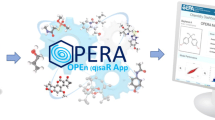Abstract
The persistence and the removal of organic chemicals from the atmosphere are largely determined by their reactions with the OH radical and O3. Experimental determinations of the kinetic rate constants of OH and O3 with a large number of chemicals are tedious and resource intensive and development of computational approaches has widely been advocated. Recently, ensemble machine learning (EML) methods have emerged as unbiased tools to establish relationship between independent and dependent variables having a nonlinear dependence. In this study, EML-based, temperature-dependent quantitative structure-reactivity relationship (QSRR) models have been developed for predicting the kinetic rate constants for OH (kOH) and O3 (kO3) reactions with diverse chemicals. Structural diversity of chemicals was evaluated using a Tanimoto similarity index. The generalization and prediction abilities of the constructed models were established through rigorous internal and external validation performed employing statistical checks. In test data, the EML QSRR models yielded correlation (R 2) of ≥0.91 between the measured and the predicted reactivities. The applicability domains of the constructed models were determined using methods based on descriptors range, Euclidean distance, leverage, and standardization approaches. The prediction accuracies for the higher reactivity compounds were relatively better than those of the low reactivity compounds. Proposed EML QSRR models performed well and outperformed the previous reports. The proposed QSRR models can make predictions of rate constants at different temperatures. The proposed models can be useful tools in predicting the reactivities of chemicals towards OH radical and O3 in the atmosphere.




Similar content being viewed by others
References
Afantitis A, Melagraki G, Koutentis PA, Sarimveis H, Kollias G (2011) Ligand-based virtual screening procedure for the prediction and the identification of novel β-amyloid aggregation inhibitors using Kohonen maps and Counterpropagation Artificial Neural Networks. Eur J Med Chem 46:497–508
Alexander DL, Tropsha A, Winkler DA (2015) Beware of R2: simple, unambiguous assessment of the prediction accuracy of QSAR and QSPR models. J Chem Inf Model 55:1316–1322
Aschmann SM, Arey J, Atkinson R (2011) Kinetics and products of the reaction of OH radicals with 3-methoxy-3-methyl-1-butanol. Environ Sci Technol 45:6896–6901
Atkinson R, Arey J (2003) Atmospheric degradation of volatile organic compounds. Chem Rev 103:4605–4638
Atkinson R, Carter WPL (1984) Kinetics and mechanisms of the gas-phase reactions of ozone with organic compounds under atmospheric conditions. Chem Rev 84:437–470
Basant N, Gupta S, Singh KP (2015a) Predicting toxicities of diverse chemical pesticides in multiple avian species using tree-based QSAR approaches for regulatory purposes. J Chem Inf Model 55:1337–1348
Basant N, Gupta S, Singh KP (2015b) Predicting aquatic toxicities of chemical pesticides in multiple test species using nonlinear QSTR modeling approaches. Chemosphere 139:246-255
Breiman L (1996) Bagging predictors. Mach Learn 24:123–140
Chai T, Draxler RR (2014) Rootmean square error (RMSE) or mean absolute error (MAE)? arguments against avoiding RMSE in the literature. Geosci Model Dev 7:1247–1250
ChemSpider www.chemspider.com
Chen Z, Yu X, Huang X, Zhang S (2014) Prediction of reaction rate constants of hydroxyl radical with organic compounds. J Chil Chem Soc 59:2252–2259
Coops NC, Waring RH, Beier C, Roy-Jauvin R, Wang T (2011) Modeling the occurrence of 15 coniferous tree species throughout the Pacific Northwest of North America using a hybrid approach of a generic process-based growth model and decision tree analysis. Appl Veg Sci 14:402–414
Dietterich TG (2000) Ensemble methods in machine learning. Lect Notes Comput Sci 1857:1–15
Erdal HI, Karakurt O (2013) Advancing monthly streamflow prediction accuracy of CART models using ensemble learning paradigms. J Hydrol 477:119–128
Ertl P, Rohde B, Selzer P (2000) Fast calculation of molecular polar surface area as a Sum of fragment-based contributions and its application to the prediction of drug transport properties. J Med Chem 43:3714–3717
Fatemi MH (2006) Prediction of ozone tropospheric degradation rate constant of organic compounds by using artificial neural networks. Anal Chim Acta 556:355–363
Friedman JH (2002) Stochastic gradient boosting. Comput Stat Data Anal 38:367–378
Ghorbanzad’e M, Fatemi MH, Karimpour M, Andersson PL (2011) Quantitative and qualitative prediction of corneal permeability for drug-like compounds. Talanta 85:2686–2694
Golmohammadi H, Dashtbozorgi Z, Acree WE Jr (2012) Quantitative structure-activity relationship prediction of blood-to-brain partitioning behavior using support vector machine. Eur J Pharm Sci 47:421–429
Gramatica P (2007) Principles of QSAR models validation: internal and external. QSAR Comb Sci 26:694–701
Gramatica P, Pilutti P, Papa E (2003) QSAR prediction of ozone tropospheric degradation. QSAR Comb Sci 22:364–373
Gramatica P, Pilutti P, Papa E (2004a) Validated QSAR prediction of OH tropospheric degradation of VOCs: splitting into training-test sets and consensus modeling. J Chem Inf Comput Sci 44:1794–1802
Gramatica P, Pilutti P, Papa E (2004b) A tool for the assessment of VOC degradability by tropospheric oxidants starting from chemical structure. Atmos Environ 38:6167–6175
Grosjean E, Grosjean D (1994) Rate constants for the gas-phase reactions of ozone with unsaturated aliphatic-alcohols. Int J Chem Kinet 26:1185–1191
Grosjean E, Grosjean D (1995) Rate constants for the gas-phase reaction of C-5-C-10 alkenes with ozone. Int J Chem Kinet 27:1045–1054
Grosjean E, Grosjean D (1996) Rate constants for the gas-phase reaction of ozone with 1,2-disubstituted alkenes. Int J Chem Kinet 28:461–466
Grosjean D, Grosjean E, Williams EL (1993) Rate constants for the gas-phase reactions of ozone with unsaturated alcohols, esters, and carbonyls. Int J Chem Kinet 25:783–794
Grosjean E, Grosjean D, Seinfeld JH (1996) Gas-phase reaction of ozone with trans-2-hexenal, trans-2-hexenyl acetate, ethylvinyl ketone, and 6-methyl-5-hepten-2-one. Int J Chem Kinet 28:373–382
Hancock T, Put R, Coomans D, Vander Heyden Y, Everingham Y (2005) A performance comparison of modern statistical techniques for molecular descriptor selection and retention prediction in chromatographic QSRR studies. Chemom Intell Lab Syst 76:185–196
Karbakhsh R, Sabet R (2011) Application of different chemometric tools in QSAR study of azoloadamantanes against influenza a virus. Res Pharm Sci 6:23–33
Klöpffer W, Wagner BO (2007) Atmospheric degradation of organic substances: data for persistence and long-range transport potential, Wiley-VCH Verlag GmbH & Co. KGaA. DOI: 10.1002/9783527611638
Kramp F, Paulson SE (1998) On the uncertainties in the rate coefficients for OH reactions with hydrocarbons, and the rate coefficients of the 1,3,5-trimethylbenzene and m-xylene reactions with OH radicals in the Gas phase. J Phys Chem A 102:2685–2690
Li X, Zhao W, Li J, Jiang J, Chen J, Chen J (2013) Development of a model for predicting reaction rate constants of organic chemicals with ozone at different temperatures. Chemosphere 92:1029–1034
Li C, Yang X, Li X, Chen J, Qiao X (2014) Development of a model for predicting hydroxyl radical reaction rate constants of organic chemicals at different temperatures. Chemosphere 95:613–618
Long XX, Niu JF (2007) Estimation of gas-phase reaction rate constants of alkylnaphthalenes with chlorine, hydroxyl and nitrate radicals. Chemosphere 67:2028–2034
Mahjoobi J, Etemad-Shahidi A (2008) An alternative approach for the prediction of significant wave heights based on classification and regression trees. Appl Ocean Res 30:172–177
McGillen MR, Carey TJ, Archibald AT, Wenger JC, Shallcross DE, Percival CJ (2008) Structure-activity relationship (SAR) for the gas-phase ozonolysis of aliphatic alkenes and dialkenes. Phys Chem Chem Phys 10:1757–1768
Mitra I, Saha A, Roy K (2010) Exploring quantitative structure–activity relationship studies of antioxidant phenolic compounds obtained from traditional Chinese medicinal plants. Mol Simul 36:1067–1079
Netzeva TI, Worth A, Aldenberg T, Benigni R, Cronin MT, Gramatica P, Jaworska JS, Kahn S, Klopman G, Marchant CA, Myatt G, Nikolova-Jeliazkova N, Patlewicz GY, Perkins R, Roberts D, Schultz T, Stanton DW, van de Sandt JJ, Tong W, Veith G, Yang C (2005) Current status of methods for defining the applicability domain of (quantitative) structure-activity relationships. The report and recommendations of ECVAM Workshop 52. Altern Lab Anim 33:155–173
Öberg T (2005) A QSAR for the hydroxyl radical reaction rate constant: validation, domain of application, and prediction. Atmos Environ 39:2189–2200
Pan Y, Jiang J, Wang R, Cao H (2008) Advantages of support vector machine in QSPR studies for predicting auto-ignition temperatures of organic compounds. Chemometr Intell Lab 92:169–178
Patlewicz G, Jeliazkova N, Gallegos Saliner A, Worth AP (2008) Toxmatch—a new software tool to aid in the development and evaluation of chemically similar groups. SAR QSAR Environ Res 19:397–412
Picquet-Varrault B, Scarfogliero M, Doussin JF (2010) Atmospheric reactivity of vinyl acetate: kinetic and mechanistic study of its gas-phase oxidation by OH, O3, and NO3. Environ Sci Technol 44:4615–4621
Pompe M, Veber M (2001) Prediction of rate constants for the reaction of O3 with different organic compounds. Atmos Environ 35:3781–3788
Puzyn T, Rasulev B, Gajewicz A, Hu X, Dasari TP, Michalkova A, Hwang HM, Toropov A, Leszczynska D, Leszczynski J (2011) Using nano-QSAR to predict the cytotoxicity of metal oxide nanoparticles. Nat Nanotechnol 6:175–178
Raff JD, Hites RA (2006) Gas-phase reactions of brominated diphenyl ethers with OH radicals. J Phys Chem A 110:10783–10792
Reitermanov Z (2010) Data splitting. WDS’10 Proceedings of Contributed Papers. Part I, 31–36
Ren YY, Liu HX, Yao XJ, Liu MC (2007) Prediction of ozone tropospheric degradation rate constants by projection pursuit regression. Anal Chim Acta 589:150–158
Roy K, Das RN (2015) The ETA indices in QSAR/QSPR/QSTR research. In: Roy K (ed) Quantitative structure-activity relationships in drug design, predictive toxicology and risk assessment, chapter 2. IGI Global, Hershey, pp 48–83
Roy PP, Kovarich S, Gramatica P (2011) QSAR model reproducibility and applicability: a case study of rate constants of hydroxyl radical reaction models applied to polybrominated diphenyl ethers and (benzo-)triazoles. J Comput Chem 32:2386–2396
Roy K, Kar S, Das RN (2015a) A primer on QSAR/QSPR modeling fundamental concepts, Springer briefs in molecular science. Springer Cham Heidelberg, New York. doi:10.1007/978-3-319-17281-1
Roy K, Kar S, Das RN (2015b) Understanding the basics of QSAR for applications in pharmaceutical sciences and risk assessment. Academic Press, London, ISBN: 978-0-12-801505-6
Roy K, Kar S, Ambure P (2015c) On a simple approach for determining applicability domain of QSAR models. Chemom Intell Lab Syst 145:22–29
Roy K, Das RN, Ambure P, Aher RB (2016) Be aware of error measures. Further studies on validation of predictive QSAR models. Chemom Intell Lab Syst 152:18–33
Rücker C, Rücker G, Meringer M (2007) Y-randomization and its variants in QSPR/QSAR. J Chem Inf Comput Sci 47:2345–2357
Ruecker C, Kuemmerer K (2012) Modeling and predicting aquatic aerobic biodegradation—a review from a user’s perspective. Green Chem 14:875–887
Samat NHA, Abdualkader AM, Mohamed F, Abdullahie AD (2014) Group- based quantitative structural activity relationship analysis of b cell lymphoma extra large (BCL-XL) inhibitors. Int J Pharm Pharm Sci 6:284–290
Singh KP, Gupta S, Mohan D (2014a) Evaluating influences of seasonal variations and anthropogenic activities on alluvial groundwater hydrochemistry using ensemble learning approaches. J Hydrol 511:254–266
Singh KP, Gupta S, Kumar A, Mohan D (2014b) Multispecies QSAR modeling for predicting the aquatic toxicity of diverse organic chemicals for regulatory toxicology. Chem Res Toxicol 27:741–753
Singh KP, Gupta S, Basant N (2015) In silico prediction of cellular permeability of diverse chemicals using qualitative and quantitative SAR modeling approaches. Chemom Intell Lab Syst 140:61–72
Snelder TH, Lamouroux N, Leathwick JR, Pella H, Sauquet E, Shanker U (2009) Predictive mapping of the natural flow regimes of France. J Hydrol 373:57–67
Tropsha A, Golbraikh A, Cho WJ (2011) Development of kNN QSAR models for 3-arylisoquinoline antitumor agents. Bull Kor Chem Soc 32:2397–2404
Wang YN, Chen JW, Li XH, Wang B, Cai XY, Huang LP (2009) Predicting rate constants of hydroxyl radical reactions with organic pollutants: algorithm, validation, applicability domain, and mechanistic interpretation. Atmos Environ 43:1131–1135
Xu X, Luan F, Liu H, Cheng J, Zhang X (2011) Prediction of the maximum absorption wavelength of azobenzene dyes by QSPR tools. Spectrochim Acta A 83:353–361
Xu Y, Yu X, Zhang S (2013) QSAR models of reaction rate constants of alkenes with ozone and hydroxyl radical. J Braz Chem Soc 24:1781–1788
Yang P, Yang YH, Zhou BB, Zomaya AY (2010) A review of ensemble methods in bioinformatics. Curr Bioinforma 5:296–308
Yap CW (2011) PaDEL-descriptor: an open source software to calculate molecular descriptors and fingerprints. J Comput Chem 32:1466–1474
Yu X, Yi B, Wang X, Chen J (2012) Predicting reaction rate constants of ozone with organic compounds from radical structures. Atmos Environ 51:124–130
Zhao CY, Zhang HX, Zhang XY, Liu MC, Hu ZD, Fan BT (2006) Application of support vector machine (SVM) for prediction toxic activity of different data sets. Toxicology 217:105–119
Acknowledgments
The authors thank the Director, CSIR-Indian Institute of Toxicology Research, Lucknow (India) for his keen interest in this work and providing all necessary facilities.
Author information
Authors and Affiliations
Corresponding author
Additional information
Responsible editor: Gerhard Lammel
Electronic supplementary material
Below is the link to the electronic supplementary material.
ESM 1
(DOCX 1876 kb)
Rights and permissions
About this article
Cite this article
Gupta, S., Basant, N., Mohan, D. et al. Modeling the reactivities of hydroxyl radical and ozone towards atmospheric organic chemicals using quantitative structure-reactivity relationship approaches. Environ Sci Pollut Res 23, 14034–14046 (2016). https://doi.org/10.1007/s11356-016-6527-2
Received:
Accepted:
Published:
Issue Date:
DOI: https://doi.org/10.1007/s11356-016-6527-2




